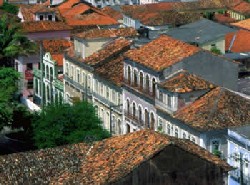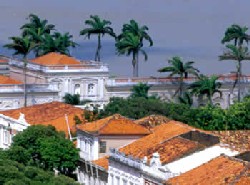Advertising by Google
São Luís, Maranhão
Area: 831 km2
Population: 867.690 people (in 2000). People born in São Luís are called "ludovicenses".
The touristic pole of Sao Luís comprises the city of Sao Luis (declared World Heritage Monument by UNESCO), and the cities of Alcântara, São José de Ribamar, Paco do Lumiar and Raposa.
São Luís is an island with the São Marcos Bay on its west side, the São José
Bay to its east, and the Atlantic Ocean to the north. It lies two degrees south
of the Equator and covers 1300 sq KM.
Four districts share the island,which are
São Luís,Raposa,Paço do Lumiar and São José Do Ribamar,and two rivers cross
São Luís: the Anil and Bacanga; both flow into the São Marcos Bay.
The city Also
has many beaches, not all suitable for bathing.
The rainy season goes from January
to July.
 Apart from the Portuguese,the island was also occupied by the French and
Dutch for short periods. With the arrival of the African slaves and through the
incorporation of the native Tupinambá Indian customs and culture, São Luís became
multicultural.
Apart from the Portuguese,the island was also occupied by the French and
Dutch for short periods. With the arrival of the African slaves and through the
incorporation of the native Tupinambá Indian customs and culture, São Luís became
multicultural.
This heterogeneity is explicit in all the region's artistic, musical
and religious manifestations. The liveliest time in the local festive calendar is
May and June,with the Divino Espírito Santo and São João festivities.This is when
the religious procession of the Divino,and the Bumba-Meu-Boi presentations take
place, among many others happen, but many others, such as the Tambor de Criuola, Tambor
de Mina, Cacuriá and the São Gonçalo dances. In São Luís ,there are still many buildings
and houses,with well-preserved façades in Portuguese tiles.
In Sao Luís, the Centro Historico (Historical Center) is the principal attraction with an ensemble of over 3,500 colonial buildings from the 17th and 8th Centuries, distributed throughout the neighborhoods of Praia Grande, Desterro, and Portinho, completely rehabilitated during the 1990s.
São Luís was founded by the French in 1612 (read more about History of Maranhão). It was later invaded by the Dutch and finally reclaimed by the Portuguese. The Centro Historico is a type of open-air museum filled with uncountable architectural elements and details, where streets covered in stones, corners, narrow side streets, balconies, inviting the visitor to wonder about the rich past of this one time rich, prestigious and promising Brazilian City.
The project of rehabilitation by the State Government encouraged private investment in the area and resulted in the opening of stores, movie theaters, museums, bars, restaurants  and hotels.
and hotels.
Historic note: why is it called São Luís?
In 1535, when king D.João III of Porutugal divided the new territory into hereditary
provinces, the island of São Luis was made part of the Maranhão province. However,it was
never occupied or marked in any away, either by the military commander in charge João
de Barros,or by any other Portuguese authority.
For another 100 years or so, it kept its
original name Upaon Açu, which means"Big Island"in the native,Tupinambá India language.
In 1612,French navigator Daniel de la Touche planted a big wooden cross roughly where
the city center is now and held mass to celebrate the formal occupation of Saint Luís,
named after King Luis XIII,in equinocial France. A wall,near where the Historic Center
of São Luís begins and a fort, by the Palácio dos Leões,are legacies of this short French
period.
In 1615,the Portuguese took back their forgotten land,only to lose it again to the
Dutch in 1641.But its definite take-over,by the Portuguese,happened in 1641.
Throughout the
long economic crisis that plagued all northern Brazil from the end of the 19ºcentury into
the 1960's,even cultural expressions,so often entangled in the wheels of time,remained
Unchanged in Maranhão.But stagnation also thwarted urban moderniziation;and ironically,
it is due to this that so much of the beautiful colonial architecture was spared in São
Luís.
When visiting São Luís, one should keep in mind that the weather here is warm year long and that most of the activities take place outdoors, with special emphasis on walks on stone paved streets. It is highly recommended wearing light clothes and comfortable walking shoes. It is also important to bring sun glasses, hats, and sunscreen, especially when visiting the beaches and the Centro Histórico.
São Luís is known as "capital of reggae" in Brazil. In no other Brazilian city is this Jamaican rythm so commonly found; many bars and dance clubs play reggae.
Photos by the Tourist Board of Maranhão.
More info and pics:
Tourist spots in São Luís. Places you should visit.
Guia São Luís. In Portuguese only. Portal of São Luís, with info about Culture, Tourism, Services and more.
São Luís by the Brazilian Heritage Foundation. In Portuguese only.
São Luís by HistoricCities.com. In Portuguese only. Several photos.
Back to Top